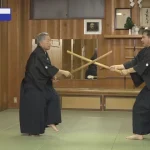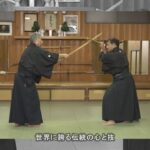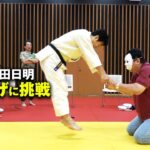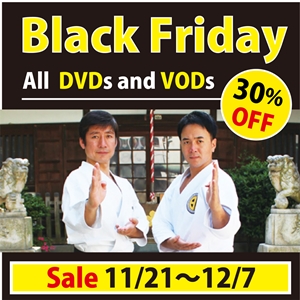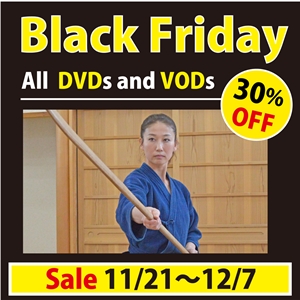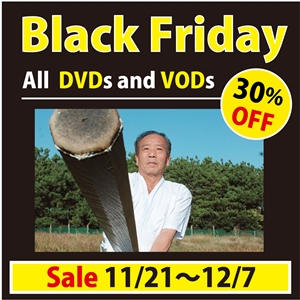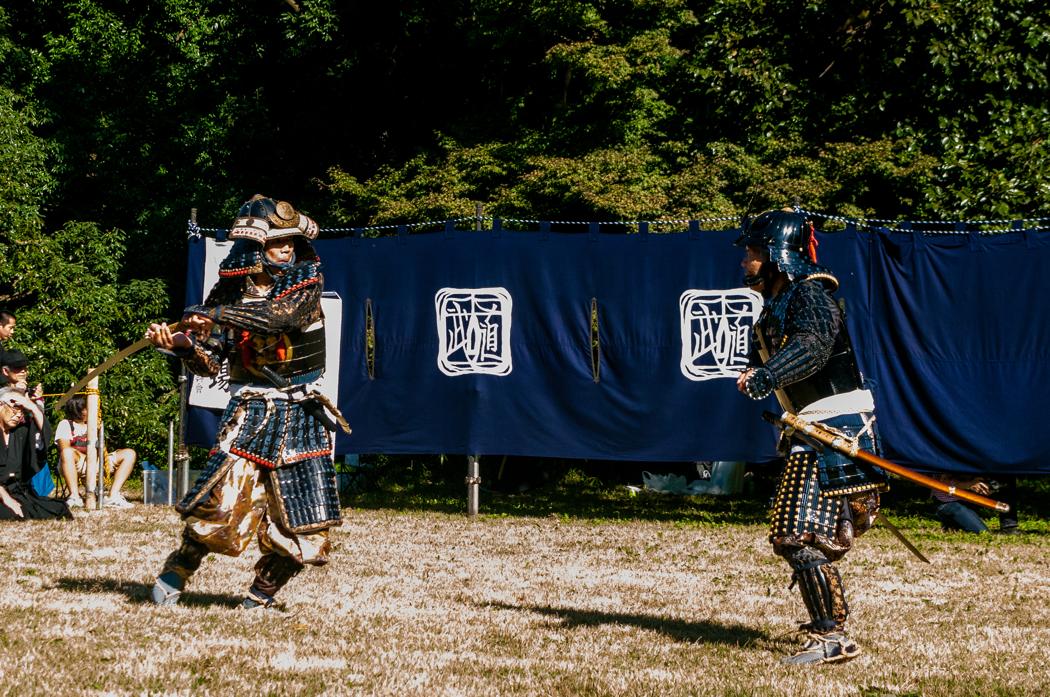
Text and photo by Grigoris A.Miliaresis
From Dogen to Rock ‘n’ Roll…
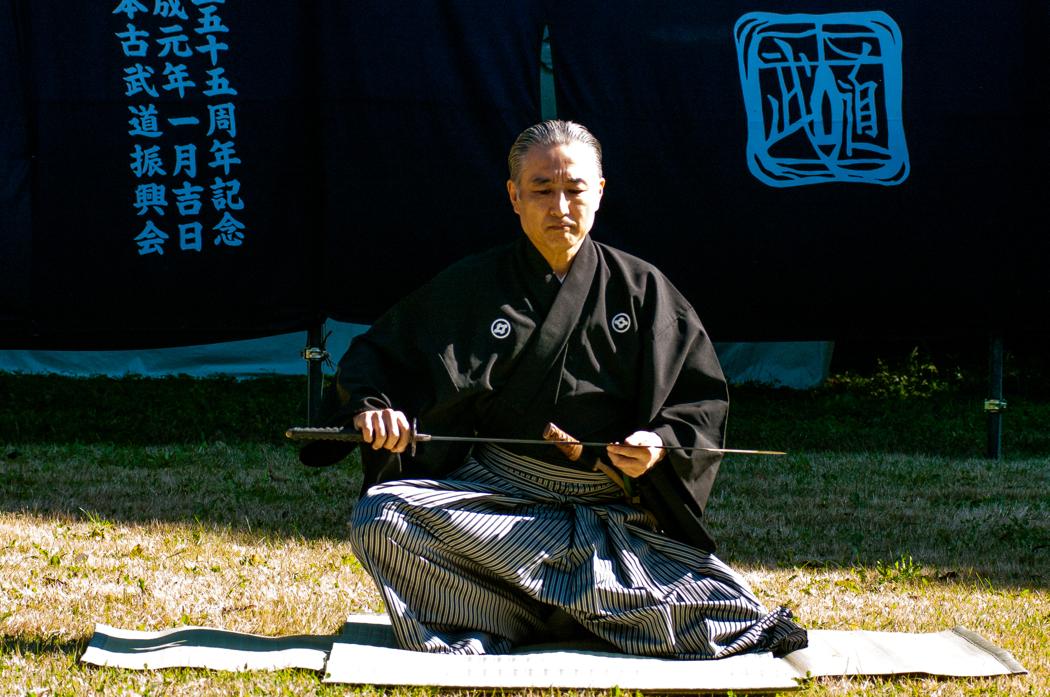 In the “Shobogenzo”, the magnum opus of 13th century Buddhism philosopher and founder of the Soto Zen sect in Japan, Dogen Zenji, one of the hardest chapters to understand is “Uji” (有時); in it Dogen uses a series of puns, not necessarily in a humorous way, to explain that it’s wrong to try to understand time as something separate from us. We are time, everything around us is time, existence itself is time and because existence is only in the present moment, time only exists in it. In other words, we shouldn’t be trying to over-theorize about the nature of time but instead, we should be living time by valuing each moment.
In the “Shobogenzo”, the magnum opus of 13th century Buddhism philosopher and founder of the Soto Zen sect in Japan, Dogen Zenji, one of the hardest chapters to understand is “Uji” (有時); in it Dogen uses a series of puns, not necessarily in a humorous way, to explain that it’s wrong to try to understand time as something separate from us. We are time, everything around us is time, existence itself is time and because existence is only in the present moment, time only exists in it. In other words, we shouldn’t be trying to over-theorize about the nature of time but instead, we should be living time by valuing each moment.
The lecturer in the “Dogen Sangha”, the informal zen group I’m informally involved with, created by Zen teacher and avid student of Dogen’s work, Gudo Wafu Nishijima (1919-2014) has been struggling with “Uji” for the past couple of months. Like Dogen, he grabs the essence –as most people who practice zazen- but putting it into words is difficult. Not only because trying to make sense of what a Buddhism teacher wrote 800 years ago is difficult by default. But also because growing up, we all get our heads filled with notions about what is time and what is our relationship with it –and these notions don’t always agree with Dogen’s idea of “time equals existence”.
Pretty much like our British lecturer in Dogen Sangha, or anyone who has grown in the West the last 50 years for that matter, rock n’ roll has played a big part in my development: it was through it that I was first exposed to some of mankind’s big questions –and an attempt to answer them. When it comes to time, rock n’ roll’s Big Chameleon, David Bowie in his 1973 masterpiece of the same title, sees it as an evil predator lurking in the shadows setting thus the tone for at least one generation’s perception of it: time is bad and not just because it creates old people like our parents, our teachers and all those that don’t understand us.
When your understanding of time has been formed by interpretations like Bowie’s (and delivered in ways as powerful as his when he sings it in “Aladdin Sane”) –not to mention by seeing its decaying effect on the world around you- Dogen’s idea that time is existence becomes hard to comprehend. And, because I’m sure many of you are wondering, this is where the subject of koryu bugei, the classic martial arts of Japan ties with the whole matter: if there is one tangible proof that existence is time, these schools is it. And yes, I’ll grant you that this is also true for all traditional arts, but this is a martial arts publication!
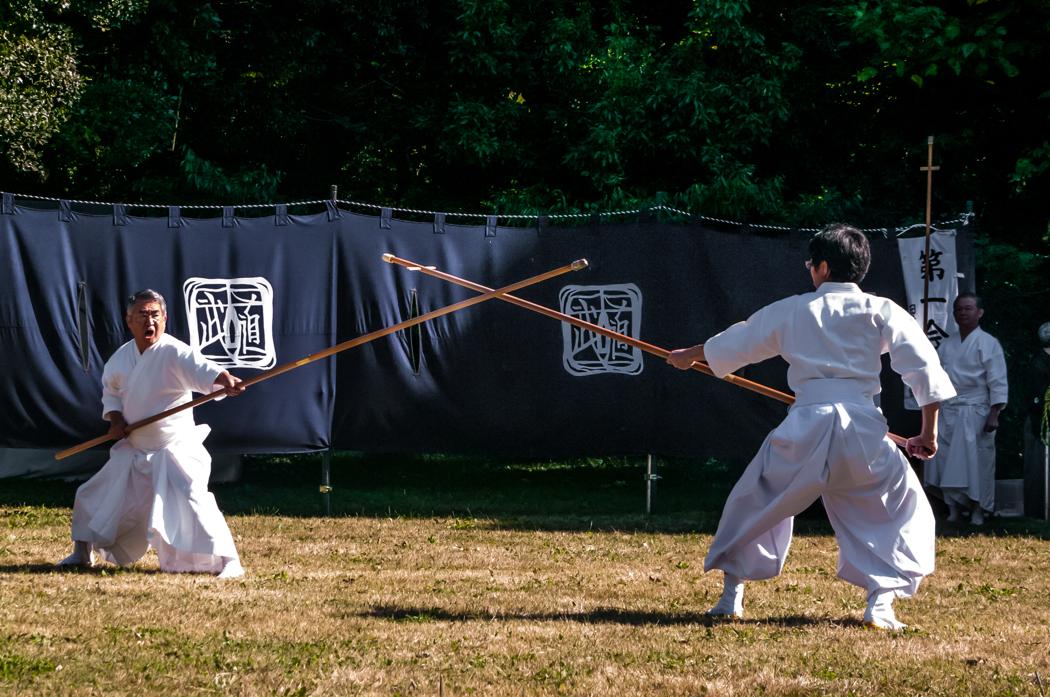
…and back to koryu
I’ll come back to why koryu bugei are the perfect example of Dogen’s “Uji” but first I need to point out that there is one more reason why this article is concerned with time: my visit to the big Kobudo Enbu Taikai in the Meiji Jingu this year was after a two-year sabbatical from this event. Personal reasons and general life circumstances have kept me away from the Emperor’s Garden and going there on this year’s Day of Culture was a somewhat strange experience. Getting there in the morning of the demonstration and actually crossing the gate was my first realization that time had passed and that there was a good chance things weren’t going to be the same.
I don’t mean that literally: of course things weren’t going to be the same! In fact, my last account of the Meiji Jingu Kobudo Enbu Taikai revolved around the idea of change itself and how it is an inherent part of koryu bugei and all other traditions. What I mean is that two years, although not a lifetime, is a period long enough to allow you to see how time affects things and people and by “people” I also mean myself. In these two years I might have not attended the demonstration (actually I haven’t attended any koryu bugei demonstration) but I have continued practicing, I’ve actually broadened my practice by beginning to study another tradition and, mostly thanks to “Hiden”, I’ve managed to see from up close a few more schools.
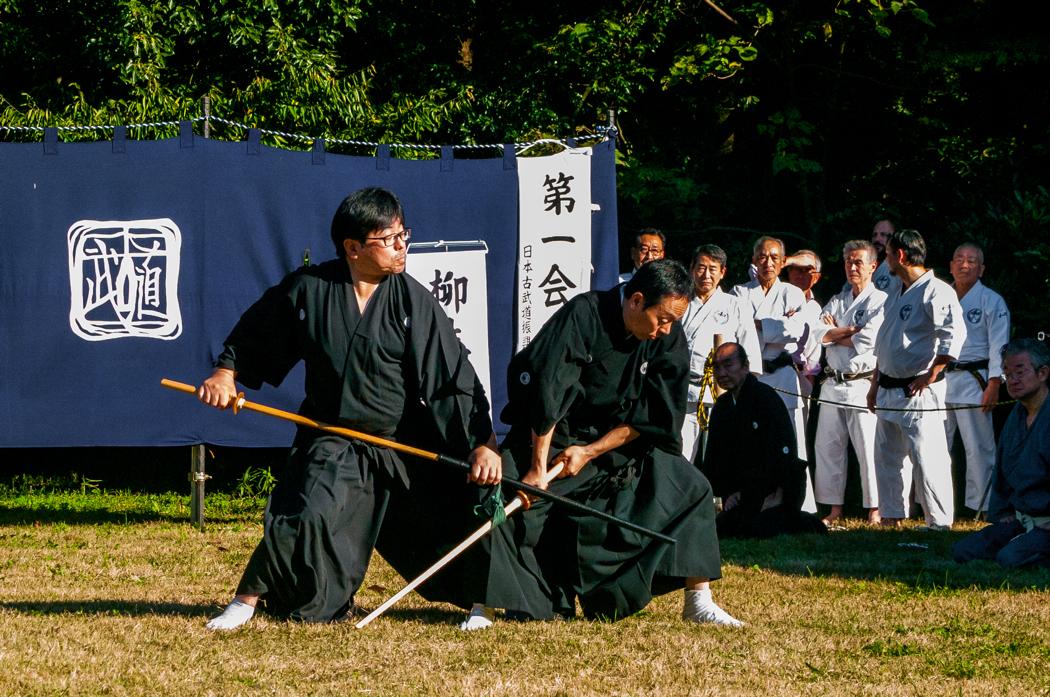
Opening notes
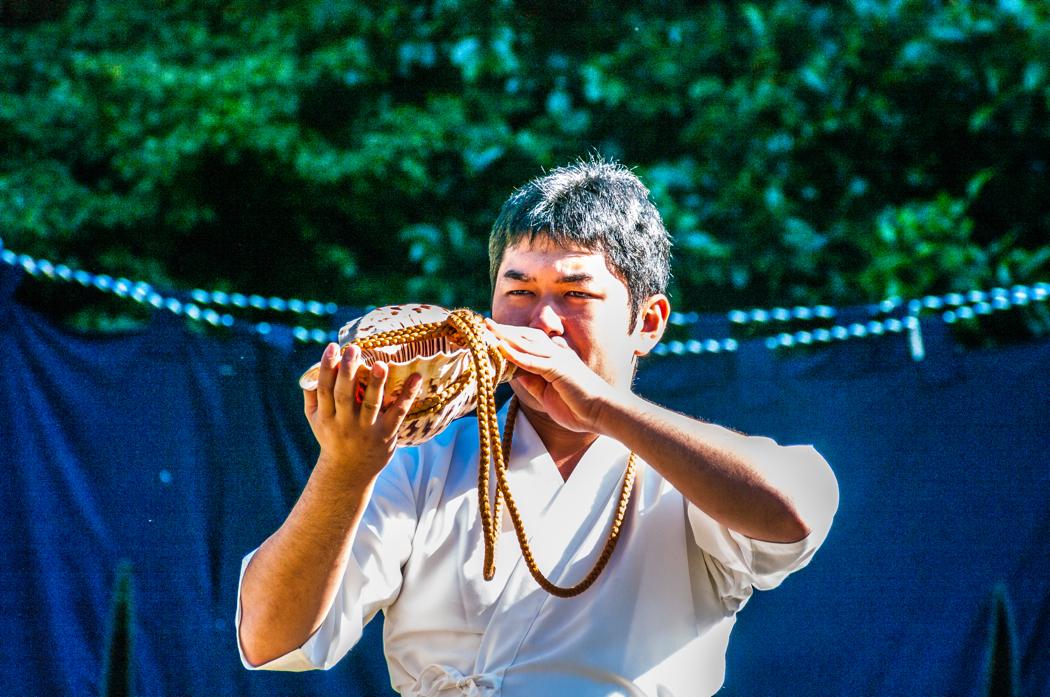 The demonstration started –with Takeda-ryu’s jingai jutsu, i.e. the art of sending signals with conch shells. Time is an essential part of music and the sounds of Takeda-ryu practitioners’ shells seemed to last centuries: how old are these shells? When did their sounds echo for the first time? Deep in the bottom of the sea by Triton, messenger of the sea and son of its god, Poseidon, who used them to calm the waves -or stir them!- back in the timeless times of Greek mythology? Or in the mountains of Tibet symbolizing the deep, penetrating sound of dharma that connects Vishnu to Sakyamuni and through the dozens of patriarchs to us? Shells can be fossils and fossils are time frozen, time that has become matter.
The demonstration started –with Takeda-ryu’s jingai jutsu, i.e. the art of sending signals with conch shells. Time is an essential part of music and the sounds of Takeda-ryu practitioners’ shells seemed to last centuries: how old are these shells? When did their sounds echo for the first time? Deep in the bottom of the sea by Triton, messenger of the sea and son of its god, Poseidon, who used them to calm the waves -or stir them!- back in the timeless times of Greek mythology? Or in the mountains of Tibet symbolizing the deep, penetrating sound of dharma that connects Vishnu to Sakyamuni and through the dozens of patriarchs to us? Shells can be fossils and fossils are time frozen, time that has become matter.
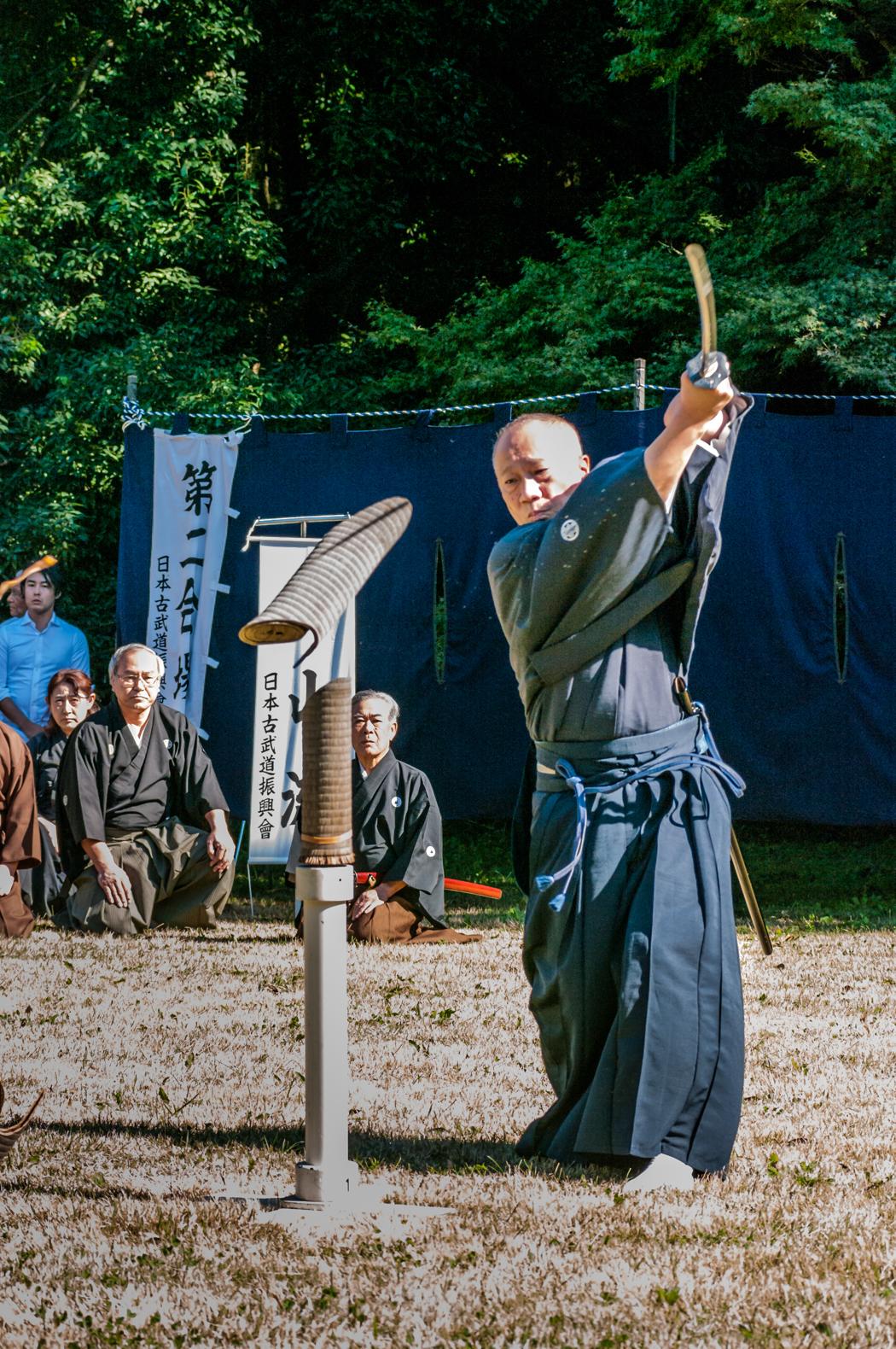 And then the parade of the ryu begun: Toyama-ryu, Sekiguchi-ryu, Shinto Muso-ryu, Kashima Shinden Jikishinkage-ryu, Ishiguro-ryu, Toda-ryu –60 schools, 60 different traditions, 60 time travels since the Sengoku Period, the early Edo Period, the last days of the Tokugawa Shogunate. Every weapon, every technique, every kata, carrying with it the inspiration of the founder and the polishing of the generations that followed him, the years of practice that teachers and seniors passed to students and juniors for decades and centuries. Every tiny fragment of this world mirrors the time that preceded it and even not very intimately involved viewers can understand that.
And then the parade of the ryu begun: Toyama-ryu, Sekiguchi-ryu, Shinto Muso-ryu, Kashima Shinden Jikishinkage-ryu, Ishiguro-ryu, Toda-ryu –60 schools, 60 different traditions, 60 time travels since the Sengoku Period, the early Edo Period, the last days of the Tokugawa Shogunate. Every weapon, every technique, every kata, carrying with it the inspiration of the founder and the polishing of the generations that followed him, the years of practice that teachers and seniors passed to students and juniors for decades and centuries. Every tiny fragment of this world mirrors the time that preceded it and even not very intimately involved viewers can understand that.
Not that there were many of those: like always the audience was fifty percent co-practitioners, friends and relatives of the people demonstrating and fifty percent non-Japanese practitioners of other, more modern martial arts who have come to learn more about these traditions that created theirs. What was interesting, and this we found out by interviewing some of them for “Hiden’s” and BudoJapan’s video channel is that even among the non-Japanese, there were many that have been attending this demonstration for years –witnesses and thanks to technology, chroniclers, to the passage of time (or not!) are not only the Japanese anymore. And this is a good thing.
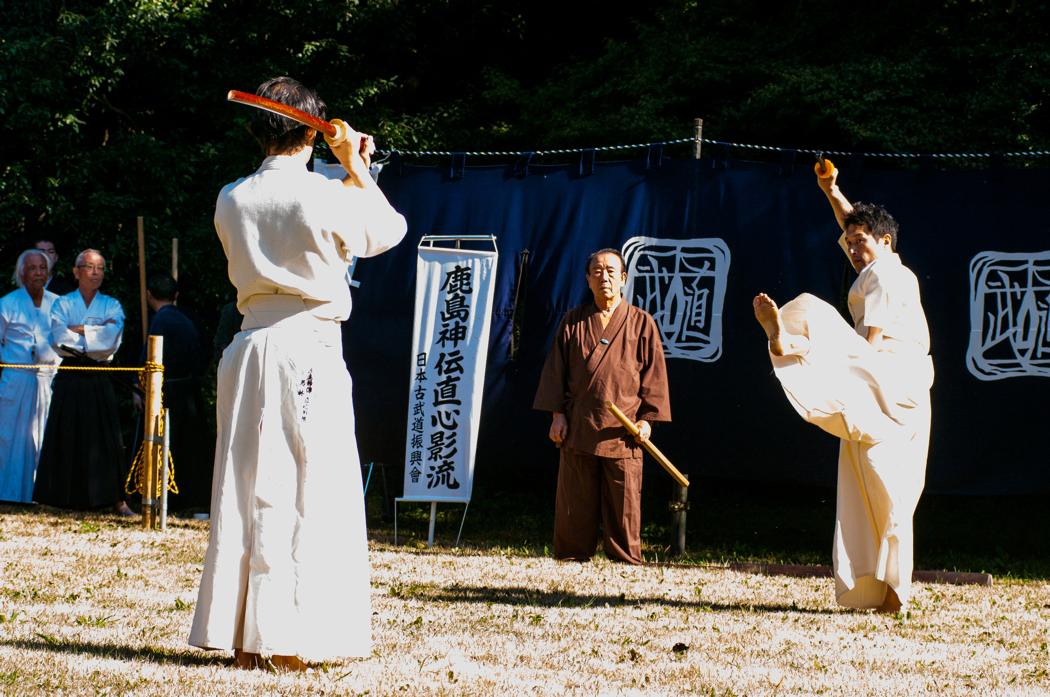
Timeless
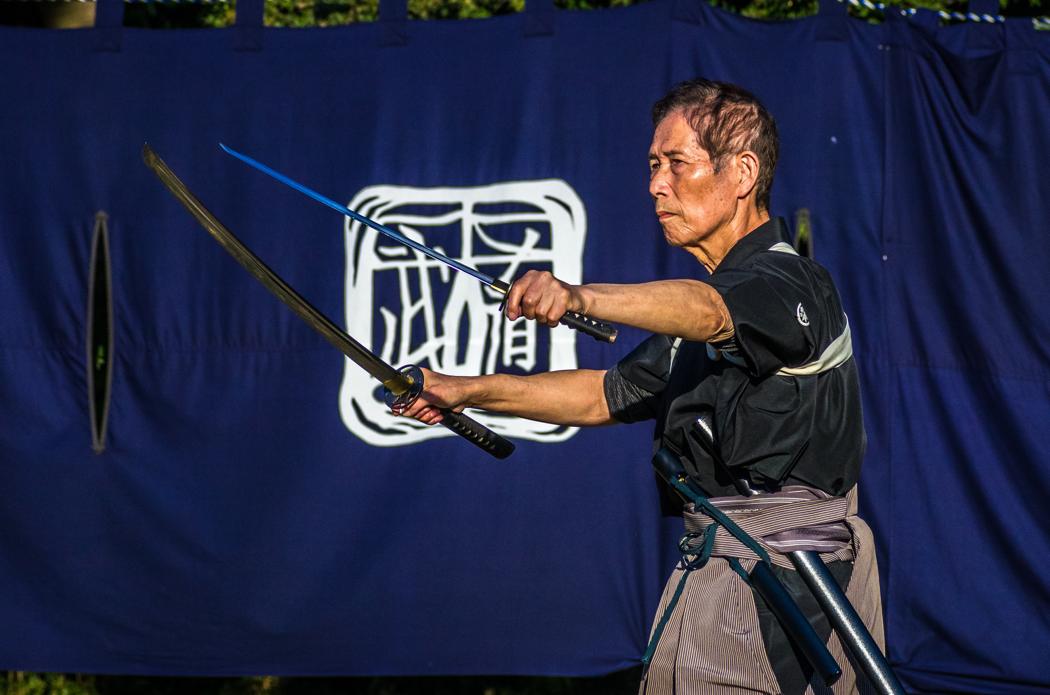 Japanese people I talk with often have difficulty in grasping the idea that there are more non-Japanese in the world than there are Japanese; scratch that to the infamous “island mentality” and the rest of the (often accurate, albeit partially) stereotypes but the truth remains: these traditions are bound to become more and more international with, well, time. They already are: especially this generation of teachers has made them more available and this and the next generations of students (some of whom are for now just interested parties) found about them through the Internet, a medium that by nature transcends time as well as space. (And by now, we all know the relationship between the two.)
Japanese people I talk with often have difficulty in grasping the idea that there are more non-Japanese in the world than there are Japanese; scratch that to the infamous “island mentality” and the rest of the (often accurate, albeit partially) stereotypes but the truth remains: these traditions are bound to become more and more international with, well, time. They already are: especially this generation of teachers has made them more available and this and the next generations of students (some of whom are for now just interested parties) found about them through the Internet, a medium that by nature transcends time as well as space. (And by now, we all know the relationship between the two.)
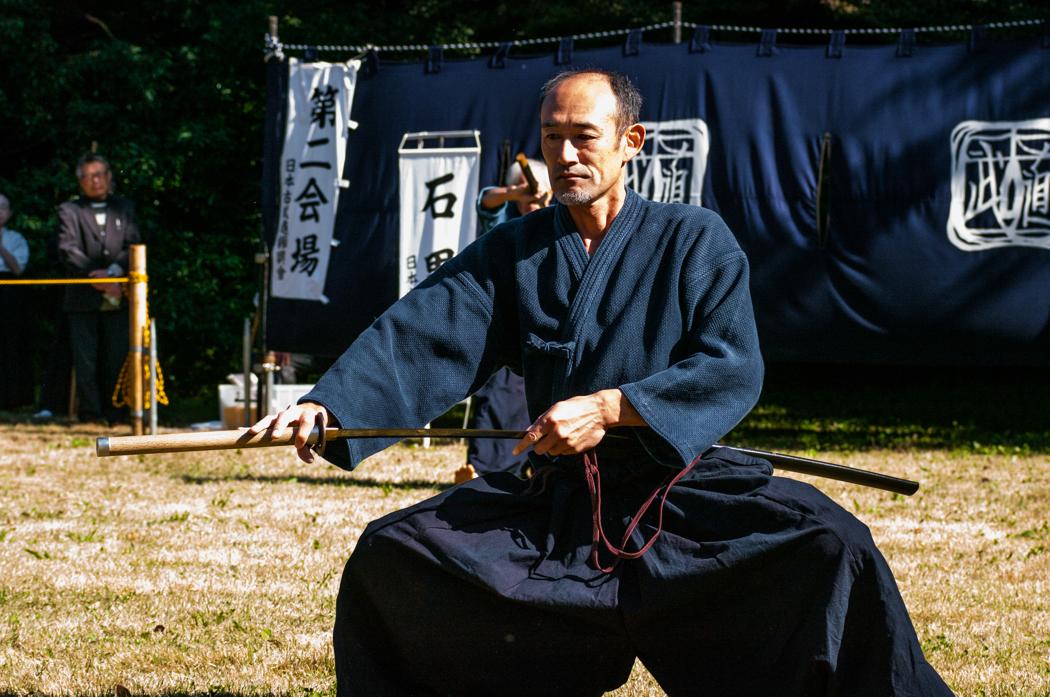 I have written it again, but it’s worth repeating: the Internet and particularly the proliferation of video-based platforms like YouTube and Vimeo have done miracles in making this peculiar, idiosyncratic universe familiar to everyone all over the world. Teachers who were once only known to their students have become well-known figures even to people who haven’t even set their foot in Japan and are been invoked in conversations about the arts and their history even by people who haven’t even set their foot in a classical art school. This is nothing short of amazing and there’s no doubt it will shape the arts in the future, starting now -besides, “the future” is just another name for the “now” that isn’t here yet, right?
I have written it again, but it’s worth repeating: the Internet and particularly the proliferation of video-based platforms like YouTube and Vimeo have done miracles in making this peculiar, idiosyncratic universe familiar to everyone all over the world. Teachers who were once only known to their students have become well-known figures even to people who haven’t even set their foot in Japan and are been invoked in conversations about the arts and their history even by people who haven’t even set their foot in a classical art school. This is nothing short of amazing and there’s no doubt it will shape the arts in the future, starting now -besides, “the future” is just another name for the “now” that isn’t here yet, right?
What many people don’t realize is that the videos that are responsible for the popularization of these arts are indeed an image of the schools they depict but this image is timeless i.e. it’s the same regardless if you watch it today, five years ago or after five years, whereas the schools aren’t. The teachers of videos shot ten or twenty years ago might not be with us today and the techniques as performed by their students are often different; not very different but different enough. This is what I meant before when I wrote that these schools are a living chronicle of which the video chronicles on YouTube (the ones already there and the ones the audience of this year’s Meiji Jingu have already uploaded) are only a small part.
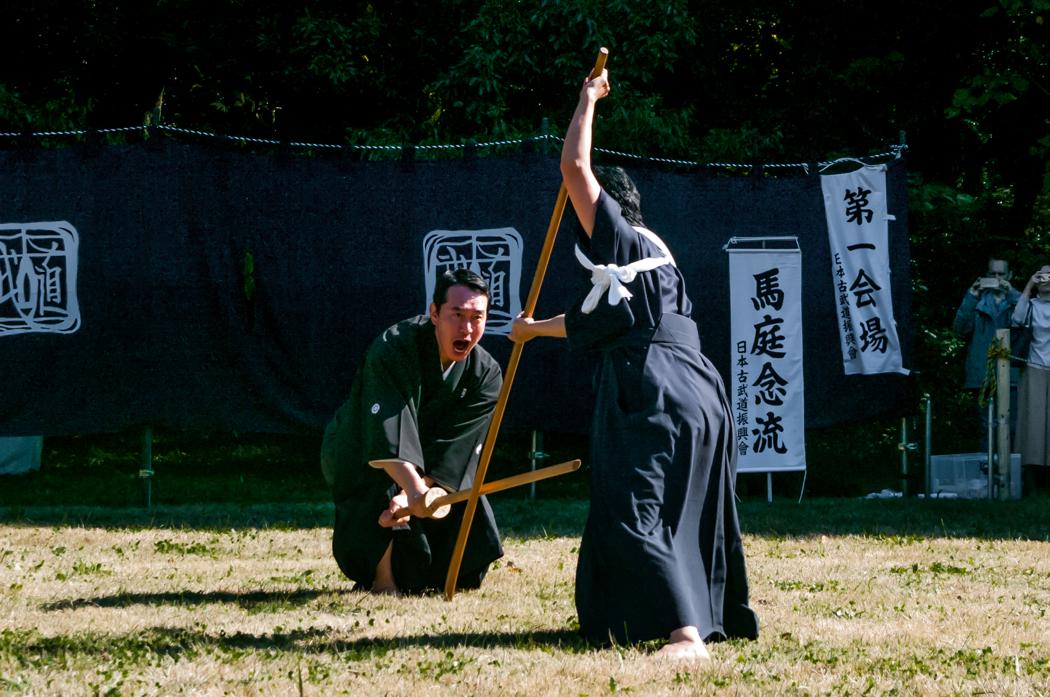
Eternity in a flash of steel
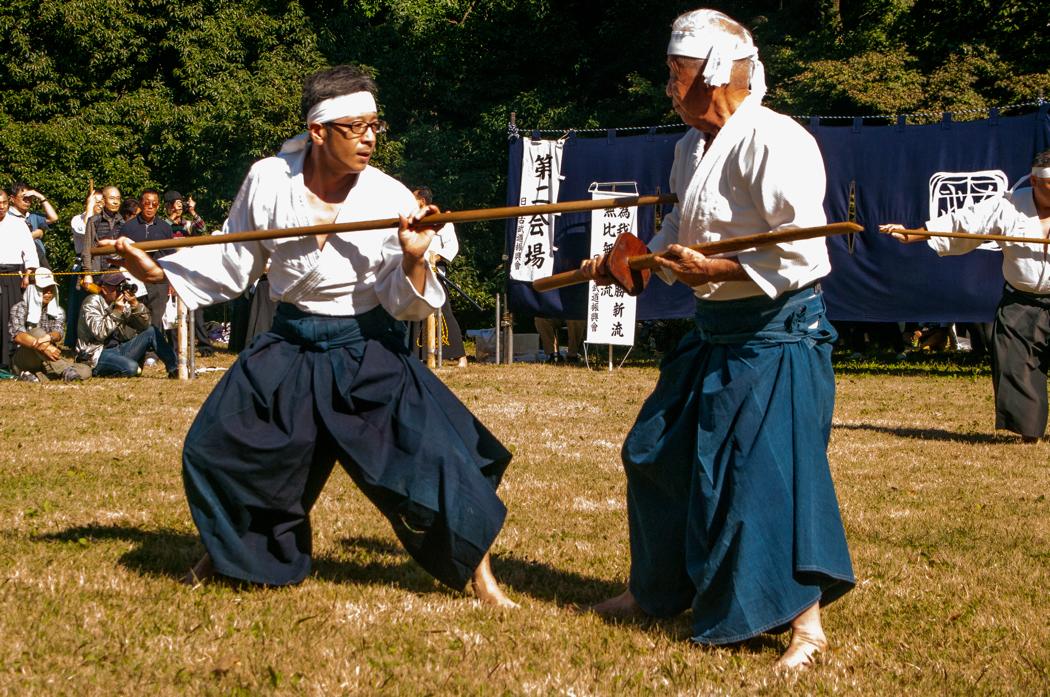 Looking around I could see the passage of time even in the span of the few years I’ve been living in Japan –and even in the two years that have passed since my last Kobudo Enbu Taikai in the Meiji Jingu. Some of the oldest teachers weren’t here and I know for a fact that we won’t be seeing a couple of them ever again: either their years have become too many to allow them to move freely or they have already passed on. Which is a sad fact but a fact nevertheless –like Bowie said, time is waiting in the wings. For all of us.
Looking around I could see the passage of time even in the span of the few years I’ve been living in Japan –and even in the two years that have passed since my last Kobudo Enbu Taikai in the Meiji Jingu. Some of the oldest teachers weren’t here and I know for a fact that we won’t be seeing a couple of them ever again: either their years have become too many to allow them to move freely or they have already passed on. Which is a sad fact but a fact nevertheless –like Bowie said, time is waiting in the wings. For all of us.
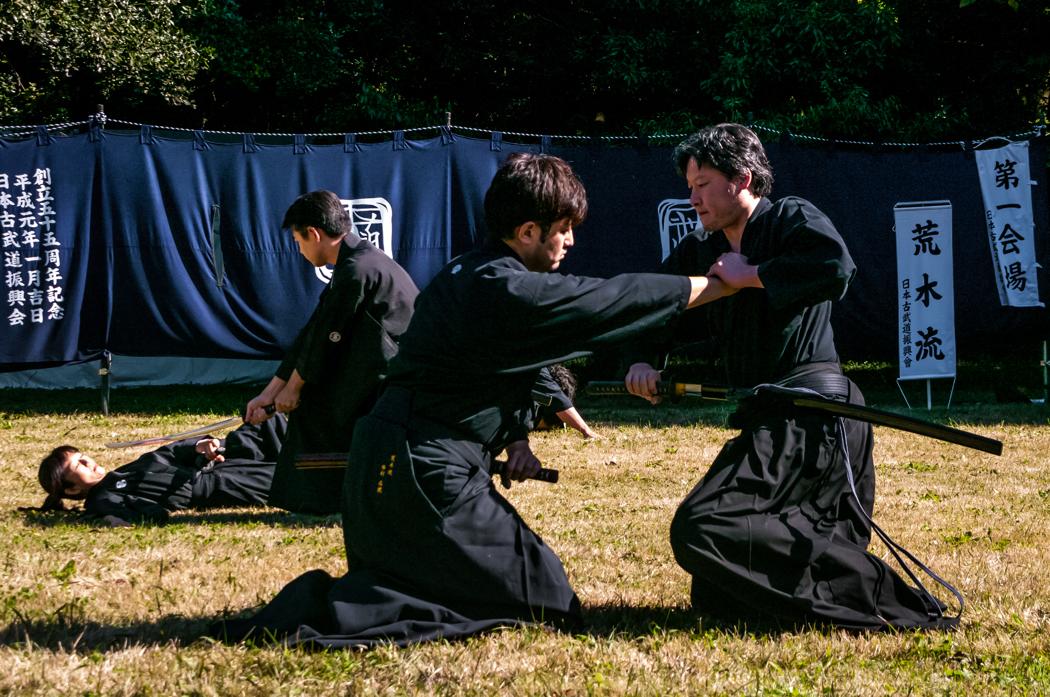 And it isn’t just the people who weren’t there. The people who were there, were another monument to the passage of time: lines in faces that used to be smoother, white strands in hair that used to be blacker, tardiness in movements that used to be nimbler, cracks in weapons that used to be sturdier. And at the same time, at the other end of the spectrum, experience in eyes that used to be more innocent, skill in bodies that used to be more awkward and speed in feet that used to be slower. The younger and the older, the past of the ryu and their future, meeting in Buddhism’s eternal now.
And it isn’t just the people who weren’t there. The people who were there, were another monument to the passage of time: lines in faces that used to be smoother, white strands in hair that used to be blacker, tardiness in movements that used to be nimbler, cracks in weapons that used to be sturdier. And at the same time, at the other end of the spectrum, experience in eyes that used to be more innocent, skill in bodies that used to be more awkward and speed in feet that used to be slower. The younger and the older, the past of the ryu and their future, meeting in Buddhism’s eternal now.
One of the most famous concepts of Yayoi Kusama, one Japan’s greatest artists is the infinity mirror; everyone has seen an infinite mirror, even by accident, but it took someone like Kusama sensei to explore its visual and philosophical aspects. You know what I’m talking about, right? You put a pair of mirrors one against the other and the reflections feed into each other creating repetitions of anything in front of them; every time the subject moves, all reflections move with it, seemingly going on for ever. The imagery is stunning and it’s no wonder that it became one of Kusama sensei’s trademark artistic and expression media.
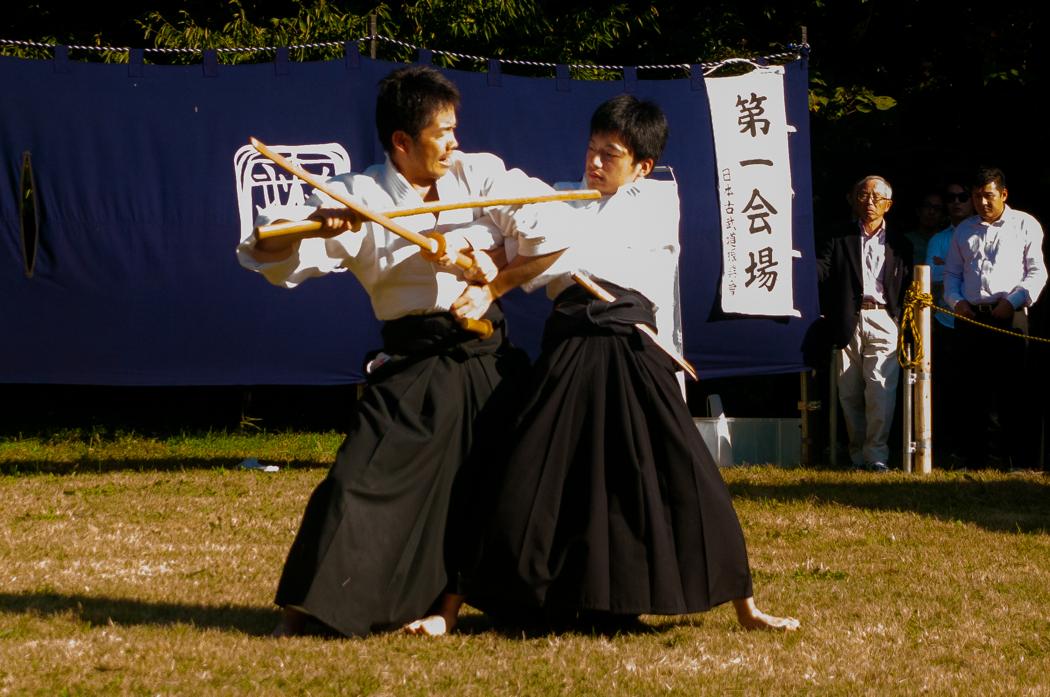
How is it possible to see the exponents of Takenouchi-ryu, of Tenshinsho-den Katori Shinto-ryu, Kashima Shinden Jikishinkage-ryu or Ono-ha Itto-ryu and not see an endless imagery of exponents of their ryu going back to Takenouchi Chunagon Daijo Hisamori, Iizasa Choisai Ienao, Matsumoto Bizen-no-Kami Naokatsu or Ito Ittosai Kagehisa? And yes, the movements won’t be the exact same as happens with those of the images in the actual infinity mirrors: there will be the differences that each generation has inserted into the techniques, the postures and the kata. But like an A note played by the orchestra when it tunes before the concert, the minor differences make for a more full-bodied tone.
Many believe that time has been cruel to Japan’s martial traditions but I could never see it that way; in fact, I honestly believe the time we live in is perfect. (One could argue that this is Dogen’s/Zen Buddhism’s influence: every time is perfect time because every time is the only time there is!) There are enough schools alive to give us a pretty good approximation of the magnificent and intricate budo tapestry of the previous centuries, there are places like this where the schools demonstrate and we can gather, see them and ask the people practicing them information about them and there is an infinite amount of information in books, videos and websites that can put what we see in context. Even if we don’t practice ourselves, we can become reasonably educated viewers, provided we approach the matter with a cool and clear head.
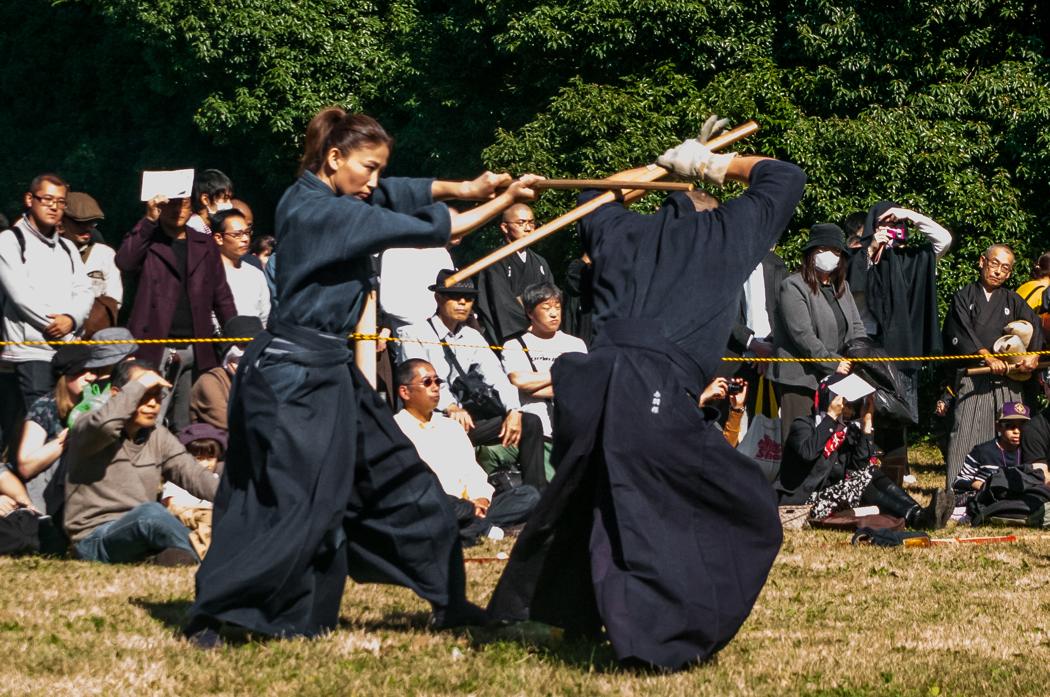
Coda
And sometimes for this head to become cool and clear, a break is necessary –at least it was for me! This two-year break made me appreciate more the polyphonic harmony of the koryu world and remind me that it isn’t only by chance that these schools have survived. Furthermore since I myself have become more involved and have raised my personal level of understanding, I could appreciate more what I saw. For example, I know I have seen before the bojutsu of Chokugen-ryu but this was the first time it registered and it was amazing to watch how the practitioners are handling the differences in distancing. And the same goes for the jojutsu of Tendo-ryu; the kumitachi of Takenouchi-ryu was another eye-opener but for different reasons: I hadn’t seen it before and I can honestly say that I was impressed with how well rounded is the kenjutsu of a school that is mostly known for the unarmed part of its curriculum!
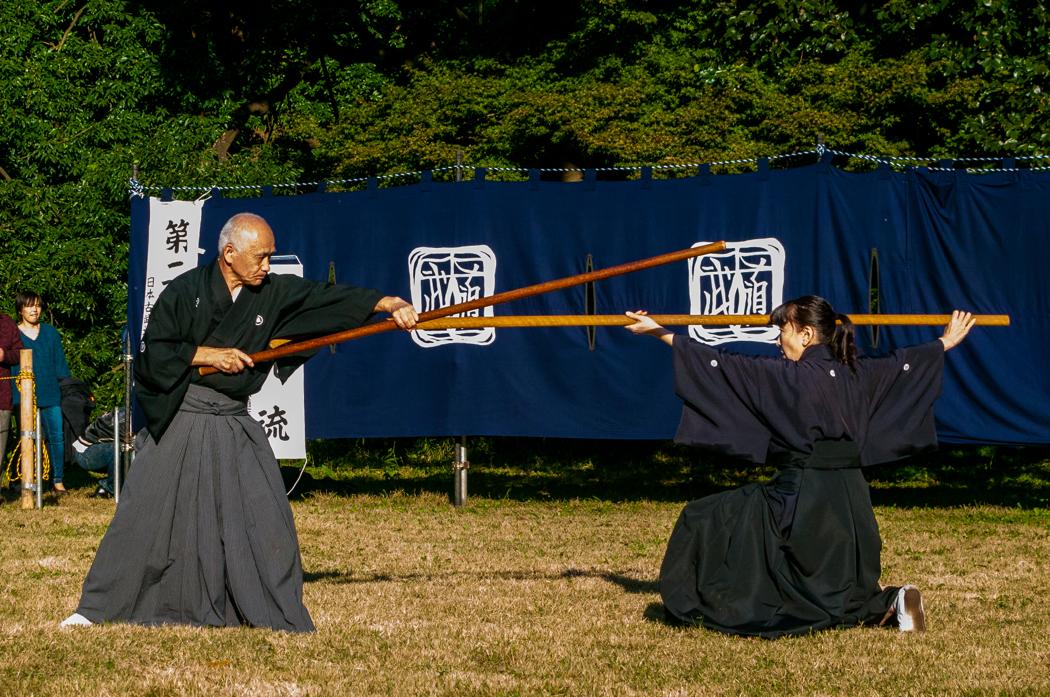
Morishige-ryu marked the ending of the enbu; that its finale would be aural seemed appropriate to the way it started. But whereas the conch-shells of the Takeda-ryu went on for ages, the blasts from Morishige-ryu’s guns were instant, putting an unequivocal ending to the proceedings and reminding us that each moment in time, marked as it was with the gunshots, is complete in itself. But like the gunshots’ echoes that traveled over the Meiji Jingu park’s trees, the echoes of the enbu traveled in the minds of all present, demonstrators and audience reminding us that each moment is simultaneously evanescent and eternal –much like these precious traditions who through embodying the mushin, the empty mind, they have made time their biggest ally.
Or like the Rolling Stones would say, “Time is on our side” –could there be a more appropriate ending for something that started with David Bowie?
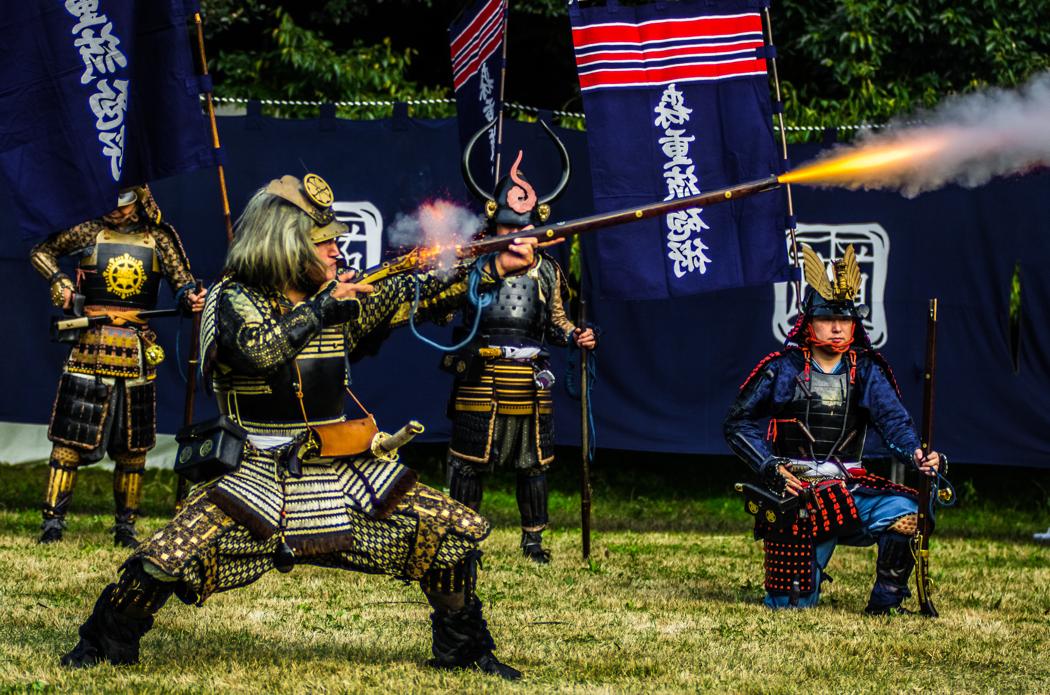
 About the author
About the author
Grigoris Miliaresis has been practicing Japanese martial arts since 1986. He has dan grades in judo, aikido and iaido and has translated in Greek over 30 martial arts’ books including Jigoro Kano’s “Kodokan Judo”, Yagyu Munenori’s “The Life-Giving Sword”, Miyamoto Musashi’s “Book of Five Rings”, Takuan Shoho’s “The Unfettered Mind” and Donn Draeger’s “Martial Arts and Ways of Japan” trilogy. Since 2007 his practice has been exclusively in classic schools: Tenshin Buko-ryu Heiho under Ellis Amdur in Greece and Kent Sorensen in Japan and, since 2016, Ono-ha Itto-ryu under 17th headmaster Sasamori Takemi and 18th headmaster Yabuki Yuji.
http://about.me/grigorismiliaresis







